In yesterday's post I looked at Vladimir Putin's invasion of Ukraine and the ways in which it threw a spark into the powder keg of the global oil market, sending the prices of WTI and Brent barreling toward new record highs. As the war grinds on without a quick resolution, we could see even more explosive gains ahead.
Today I'm analyzing the supply and demand trends that got us here, in order to provide a roadmap for what we might expect from oil markets going forward.
Oil Demand on Track for New Record Highs
As recently as late 2021, the fashionable opinion on Wall Street said that oil demand had peaked with the pandemic, and it was all downhill from here. One well-known asset manager overseeing tens of billions of dollars famously called for crude oil to go the way of “whale oil”:

Fast forward 18 months later, and the oil skeptics couldn’t have been more wrong—with U.S. demand running consistently above pre-COVID levels and clearing new record highs just last month: 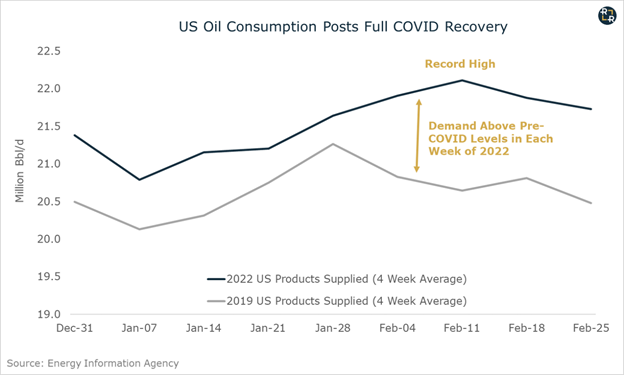
More impressive, these new highs showed up before peak seasonal demand kicks in during the summer driving season, which could unleash more upside from here.
Looking ahead, another source of potential demand upside could come from a further rebound in air travel. The chart below shows that U.S. air travel remains about 15% below the pre-COVID levels of 2019:

With COVID restrictions fading, many analysts expect U.S. air travel will stage a full recovery at some point in 2022. If true, this could help secure additional new highs in U.S. crude demand.
Finally, the rest of the globe is following America’s lead. The IEA’s latest estimates indicate global demand will grow by 3.2 million bbl/d this year to 100.6 million bbl/d. Meanwhile, the EIA projects a new record high in global demand by Q3 of this year, with further new highs in 2023 and beyond:
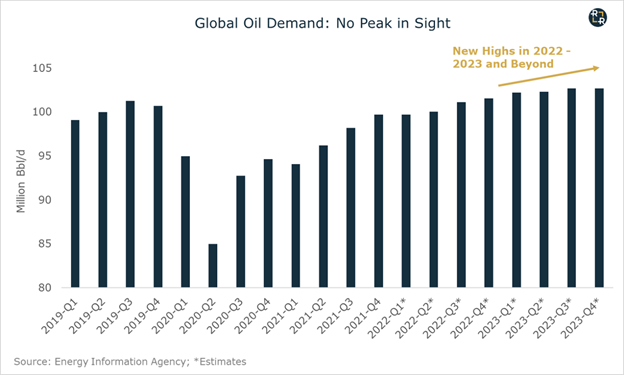
In other words, peak oil consumption is nowhere in sight. And with economies re-opening around the world, the world will need over 3 million bbl/d of new supply this year alone.
On that note, let’s consider the supply side of the equation…
U.S. Oil Production Stalled, and Higher Prices Might Not Help
Despite the best pricing environment of the last decade, U.S. oil production remains stalled out at 11.6 million bbl/d. That’s about a million bbl/d shy of pre-pandemic highs: 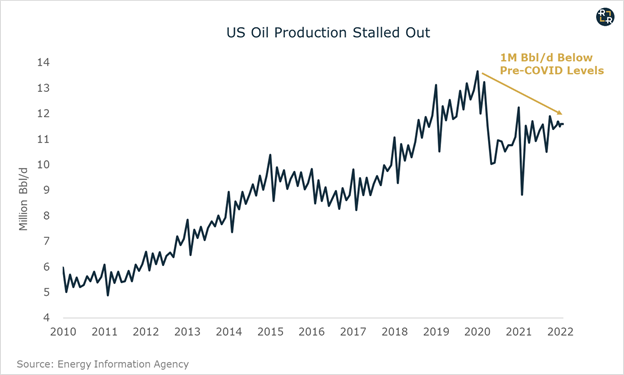
This reflects a 180 degree change from the dynamics of the last decade, when shale drillers unleashed millions of barrels of new production growth at $50–$60 oil prices.
As I've described previously, the reason for this change is two-fold: lack of capital investment, and perhaps more importantly, a lack of inventory. Shale drillers have simply exhausted core inventories in many of the key basins that boosted U.S. production during the shale boom, like the Eagle Ford and Bakken shales.
Today, the Permian basin in Texas is the last bastion for U.S. production growth. Despite adding over half a million bbl/d in new production since mid-2021, the Permian is struggling to offset declines in conventional production and the stalled output from all other U.S. shale fields:
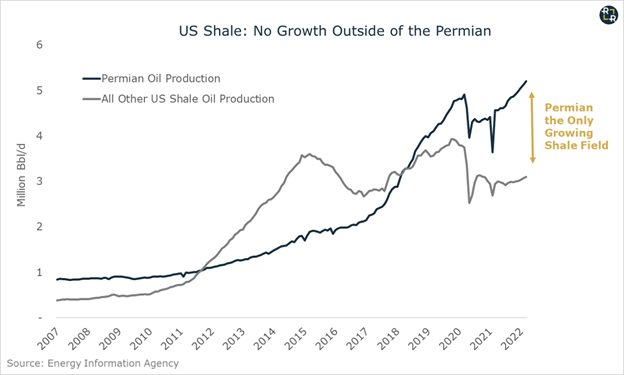
Given the exhausted inventory in shale basins outside of the Permian, it’s not clear that higher prices can solve this problem. Meanwhile, even if operators want to put rigs to work, the oil patch is dealing with an acute shortage of inputs across the board, ranging from labor to steel piping to frac sand.
The same supply chain constraints slowing down auto manufacturing and home construction are showing up in the oil patch, and there’s no easy fix here. This confluence of factors explains why, despite the recent, biggest weekly gain in crude prices ever, the U.S. oil rig count actually fell by three at the same time, though more recently it's once again crawling higher. Still, remains about 24% below pre-COVID levels:
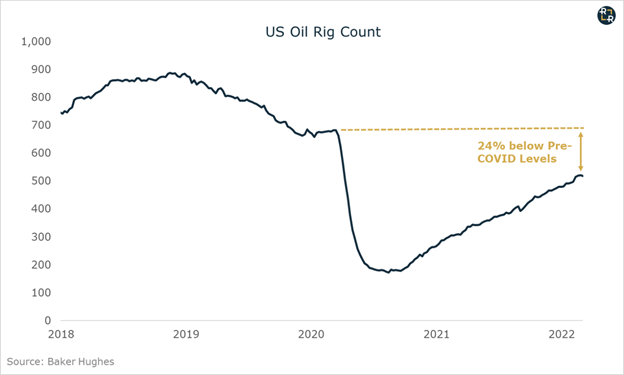
Finally, there’s the OPEC+ coalition, which is also struggling to boost output.
OPEC+ Capacity Hit by Global Capital Retreat
In the wake of the COVID-19 outbreak, OPEC+ balanced the oil market by cutting a record 9.7 million bbl/d of output. As demand rebounded, the group agreed to release 400,000 bbl/d of new supply each month, starting in July of 2021.
But for the last several months running, many of the participating countries have struggled to hit their production targets. In January, the IEA estimated that OPEC+ undershot its production quota by 900,000 barrels per day.
A big part of this shortfall can be attributed to the Western backlash against fossil fuel development. Historically, a substantial portion of OPEC+ oil production has been developed by western capital—primarily from the global supermajors. But now, slashed capital budgets among Western oil companies is creating ripple effects around the globe, as energy expert Julian Lee explained to Bloomberg:
“Persistent production shortfalls in countries like Nigeria and Angola are not the result of maintenance… rather, they reflect dwindling capacity resulting from lack of investment in exploration and development. So the shortfall will persist. In fact, it’s going to get worse, as more and more countries run up against capacity constraints and struggle to lift production.”
Thanks in part to downgraded estimates for OPEC+ production capacity, Morgan Stanley) forecasts the world’s spare capacity will shrink from 6.5 million barrels a day a year ago to below 2 million barrels a day by mid-2022:
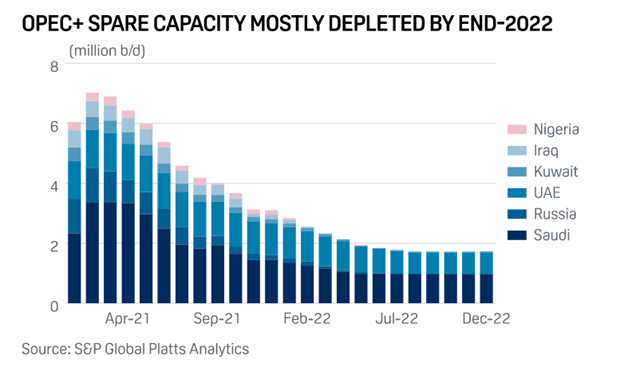
Critically, these space capacity estimates were made before the Russian invasion of Ukraine. So even assuming zero disruption to Russian supplies, the oil market was set up for a dangerous drop in spare capacity to under 2 million bbl/d by year-end.
Finally, let’s consider the potential impact on the market in the case where Russian exports remain impaired going forward.
A Demand Destroying Price Spike Could Take Oil to $200+
Every commodities bull market is born from a supply/demand imbalance. The price mechanism attempts to solve the imbalance in one of two ways: incentivize more supply, or reduce demand.
Over the past year, the oil market has signaled the need for more supply (or less demand) through a steady grind higher in prices. And yet, despite oil reaching multi-year highs above $90, producers have struggled to add enough supply. As discussed in this two part article, many of these production struggles can’t be solved by higher prices in the short-term.
Meanwhile, demand continues rebounding across the globe.
Now, the threat of losing up to 4.8 million bbl/d of Russian exports could take the supply side of this balancing act off the table. In the event of a total loss of these Russian exports, even with every other OPEC member maxing out their production capacity, the market could still face a crippling supply deficit exceeding a million bbl/d.
In that scenario, widescale demand destruction would become the only mechanism available to balance the market. It’s anyone’s guess how high prices would go in this scenario, but $200 could be just the beginning.
Of course, that scenario wouldn’t be good for anyone. For the sake of everyone on the planet, we should hope that the Russian-Ukraine situation gets resolved as soon as possible.
But for investors, this potential scenario has become one of the key risks that could impact every global asset class, and one which appears to be growing in likelihood with each passing day.
This content was originally posted at the Ross Report.
